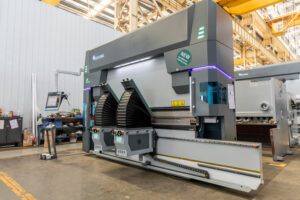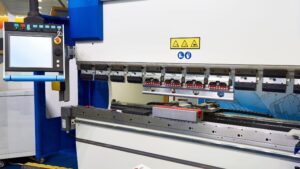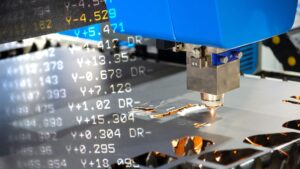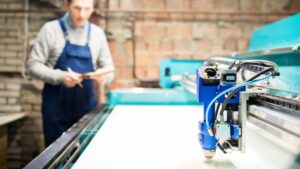Metal forming is a fundamental process in manufacturing, shaping the world of industry as we know it. Its roots trace back to ancient times, with blacksmithing and metalworking practices forming the backbone of early tool making and machinery. Fast forward to today, and metal forming has evolved into a highly sophisticated field, encompassing a variety of techniques and technologies. This evolution has been driven by the relentless pursuit of efficiency, precision, and material properties optimization.
From the earliest forges to cutting-edge CNC machines, the journey of metal forming reflects human innovation and engineering prowess. It’s a field that not only shapes metal but also our society’s capabilities in construction, transportation, and beyond.
What is Metal Forming?

Metal forming refers to the process of reshaping metal into a desired form or shape, using force and various means of deformation. It involves manipulating metal material, which can be in the form of sheets, rods, or billets, into specific shapes and sizes.
This is achieved through a variety of processes, each utilizing different forces and equipment, yet all sharing the common goal of transforming raw metal into useful components.
In simpler terms, think of metal forming like the art of origami, but instead of folding paper, it’s about bending, stretching, or compressing metal. It’s a crucial process in creating everything from everyday items like utensils and car parts to complex machinery.
What is the Difference between Hot Working and Cold Working Metal Forming?
In metal forming, hot working involves processing metals at high temperatures, enhancing ductility and reducing strength for easier shaping. Contrastingly, cold working is done at room temperature, increasing strength but requiring more force.
Let’s dive into more details below
What is Hot Working Metal Forming?
Hot working metal forming is a process conducted at temperatures above 60% of the metal’s melting point. This level is generally above the recrystallization temperature of the metal, which varies depending on the type of metal being used.
- Temperature Range: This typically means working at temperatures from just above the recrystallization point to just below the melting point of the metal. For instance, for steel, this temperature ranges from 900°C to 1250°C.
- Process Dynamics: During hot working, the grains of the metal deform as well as recrystallize simultaneously. This continuous recrystallization during deformation helps in maintaining a constant microstructure throughout the process.
- Applications: Hot rolling of steel, forging of aircraft parts, and hot extrusion of metals are common applications.
Advantages
- Greater Ductility: Hot working enhances the ductility of metals, making them more pliable and easier to shape into complex forms.
- Reduced Strength and Hardness: This facilitates easier machining and shaping as the metal offers less resistance.
- Less Force Required: Due to the softened state, the metal requires less force to deform, reducing the energy and effort needed.
- Minimal Residual Stresses: Hot working helps in relieving internal stresses within the metal, leading to more stable and distortion-free products.
- Enhanced Workability: Allows for more extensive deformation without the risk of fracture, particularly in metals like stainless steel and aluminum.
- Grain Refinement: The process can refine the grain structure of the metal, improving its mechanical properties.
- Reduced Risk of Work Hardening: Ideal for metals prone to work hardening at lower temperatures.
Disadvantages
- Higher Energy Consumption: Significant energy is required to maintain the high temperatures needed for hot working.
- Oxidation and Scaling: Exposure to high temperatures can lead to the oxidation of metals, affecting surface finish and dimensional accuracy.
- Requires Careful Temperature Control: Precise control is essential to prevent overheating or uneven heating, which can lead to defects.
- Limited Precision: The soft nature of metals at high temperatures can limit the precision of the final product.
- Tool Wear: High temperatures can accelerate the wear and tear on forming tools and machinery.
- Potential for Microstructural Changes: Improper control of temperature and cooling rates can lead to undesirable microstructural changes.
- Environmental Concerns: The energy-intensive nature of the process raises concerns regarding environmental impact and sustainability.
What is Cold Working Metal Forming?

Cold working, in contrast, is carried out at or slightly above room temperature, but below the metal’s recrystallization temperature. It involves shaping the metal without prior heating.
- Temperature Range: Generally, this is at room temperature, which means there is no intentional heating of the metal above its recrystallization point. For most metals, this is below 400°C.
- Process Characteristics: Cold working hardens the metal through the process of strain hardening, also known as work hardening. This occurs as the metal’s crystal structure is deformed and new stress points are introduced.
- Applications: Cold rolling of sheet metal, cold forging, and wire drawing are typical examples.
Advantages
- Increased Yield Strength and Hardness: Cold working strengthens the metal through strain hardening, enhancing its overall durability.
- Better Surface Finish: Often results in a smoother and more appealing finish, crucial for aesthetic applications.
- Energy Efficiency: No heating is required, making it more energy-efficient compared to hot working.
- Enhanced Dimensional Accuracy: The absence of high temperatures means more precise control over the dimensions of the final product.
- Improved Tolerance Levels: Can achieve tighter tolerances, essential for precision components.
- Grain Strengthening: Improves the grain structure of the metal, enhancing its mechanical properties.
- No Risk of Oxidation: Avoids the issues of scaling and oxidation seen in hot working.
Disadvantages
- Higher Force Requirement: Requires more force to deform the metal, demanding more powerful machinery.
- Risk of Metal Becoming Too Hard and Brittle: Can lead to cracking, especially in metals with low ductility at room temperature.
- Limited to Thinner Metal Pieces: Not suitable for excessively thick materials due to the high forces required.
- Work Hardening Limits Further Processing: The increased hardness can limit further shaping or machining without annealing.
- Potential for Residual Stresses: Unlike hot working, cold working does not relieve internal stresses, which could lead to distortion.
- Limited Ductility: Reduces the extent to which metals can be deformed without cracking.
- Tool Wear: The increased strength of the metal can cause more rapid wear on tools and dies.
Comprehensive Overview of Metal Forming Types

There are many different metal-forming processes. Below, we will give you an overview of each and include common applications and advantages. Let’s dive right in
Compressive Stress Forming
Compressive stress forming involves applying compressive forces to metal to change its shape. This is akin to squeezing or pressing the metal to alter its form, which can include processes like rolling, forging, and extrusion. These methods are used extensively in various industries to produce a wide array of products.
Rolling
Rolling is a metal forming process where the metal stock is passed through one or more pairs of rolls to reduce the thickness and to make the thickness uniform. The concept is similar to rolling out dough with a rolling pin.
Applications:
- Creating metal sheets and plates.
- Production of structural components like beams and rails.
Advantages:
- High production efficiency.
- Uniform thickness and surface finish.
Machines and Tools Required:
- Rolling mills.
- Roller tables.
- Auxiliary equipment for material handling.
Extrusion
Extrusion is a process where metal is forced through a die, resulting in a product with a uniform cross section. Imagine squeezing toothpaste from a tube; extrusion works on a similar principle but with metal.
- Applications:
- Production of tubing, pipes, and structural components.
- Creating complex cross-sectional profiles for construction and automotive sectors.
- Advantages:
- Efficient production of uniform cross-sectional shapes.
- Capability to form complex shapes with excellent surface finish.
- Machines and Tools Required:
- Hydraulic or mechanical extrusion presses.
- Dies with specific cross-sectional shapes.
- Handling and cutting equipment for extruded parts.
Die Forming
Die forming involves shaping metal sheets by pressing them into a die block. This method is akin to using a cookie cutter, where the die acts as the cutter, shaping the metal sheet into predefined forms.
Applications:
- Creating parts with intricate shapes for appliances and electronics.
- Producing components with precise tolerances in aerospace and automotive industries.
Advantages:
- High precision and repeatability.
- Suitable for mass production with minimal material waste.
Machines and Tools Required:
- Stamping presses.
- Custom-designed dies.
- Material handling systems for efficient workflow.
Forging
Forging involves shaping metal using localized compressive forces. It’s an age-old technique, reminiscent of blacksmiths hammering hot iron, but modern forging uses high-pressure machinery to achieve precision.
Applications:
- Manufacturing robust components like gears, automotive parts, and hand tools.
- Producing parts for heavy machinery and aerospace applications.
Advantages:
- Exceptional strength and durability of forged parts.
- Improved structural integrity and grain flow.
Machines and Tools Required:
- Forging presses or hammers.
- Anvils and dies.
- Heating equipment for hot forging.
Indenting
Indenting involves pressing a tool into the metal surface to create a shape or pattern. This method is not about cutting through the metal but reshaping its surface, similar to embossing.
Applications:
- Creating textured patterns on metal surfaces for aesthetic purposes.
- Forming specific functional features in metal parts for various industries.
Advantages:
- Ability to create detailed surface designs.
- Enhances both the aesthetic and functional aspects of metal parts.
Machines and Tools Required:
- Precision indenting tools or dies.
- Presses for applying controlled force.
- Alignment and holding fixtures for accurate processing.
Tensile Stress Forming

Tensile stress forming, another vital category within metal forming, employs tension to stretch or elongate metal into specific shapes. This process is akin to pulling taffy into thinner and longer pieces, where the metal is similarly extended to meet desired specifications.
Stretching
Stretching involves elongating metal sheets by applying tensile forces. This process is crucial for creating parts with minimal distortion and specific dimensional requirements.
Applications:
- Fabrication of large, flat components like aircraft skins.
- Producing parts with high strength-to-weight ratios.
Advantages:
- Uniform thickness and grain structure throughout the part.
- Reduced risk of warping or distortion.
Machines and Tools Required:
- Stretch forming machines.
- Clamping and alignment systems.
- Customized tooling for specific part geometries.
Expanding
Expanding metal involves stretching it to create a mesh or lattice structure. This process transforms a solid metal sheet into an expanded mesh, creating a variety of patterns and shapes.
Applications:
- Manufacturing of metal grates and filters.
- Production of decorative architectural elements.
Advantages:
- Efficient use of material, reducing weight without sacrificing strength.
- Versatile applications due to various available patterns.
Machines and Tools Required:
- Expansion presses or machines.
- Dies to create specific mesh patterns.
- Cutting and handling equipment for the expanded metal.
Recessing
Recessing in metal forming refers to creating recesses or depressions in a metal piece without removing material. It’s akin to pressing a design into clay, but with metal.
Applications:
- Fabrication of non-slip surfaces on metal parts.
- Creation of decorative patterns on metalwork.
Advantages:
- Preserves the integrity and strength of the metal.
- Allows for intricate designs without cutting through the material.
Machines and Tools Required:
- Precision presses.
- Custom-designed recessing dies.
- Surface finishing equipment.
Combined Stress Forming
Combined stress forming is a sophisticated approach in metal forming, integrating both tensile and compressive stresses. This method allows for more complex shapes and designs, broadening the scope of metal forming capabilities. It includes various specialized techniques like deep drawing and spinning, which are indispensable in creating diverse metal components, from kitchen utensils to automotive parts.
Techniques in Combined Stress Forming
- Pulling Through a Die: Shapes metal by pulling it through a die, altering its cross-section.
- Tandem Rolling Mill: Utilizes a series of rolling actions to gradually shape the metal.
- Deep Drawing: Forms metal sheets into deep, hollow shapes like pots and pans.
- Spinning: Rotates a metal disc or tube to form symmetrical parts like cones.
- Flange Forming: Bends the edges of metal sheets to create flanges.
- Upset Bulging: Expands a portion of a metal piece, often used in creating hollow parts.
Other Metal Forming Processes
Shearing
Shearing is a cutting process where metal sheets are sliced by applying a great shearing force, akin to cutting paper with scissors but on an industrial scale.
Applications:
- Trimming metal sheets to size.
- Cutting components for further processing in manufacturing.
Advantages:
- Precise and clean cuts.
- Efficient for high-volume production.
Machines and Tools Required:
- Shearing machines.
- Blades specifically designed for different metal types and thicknesses.
- Material handling systems for processed sheets.
Bending
Sheet metal bending involves deforming metal around a certain axis, creating a bend or fold. It’s like folding a piece of paper, but with metal, requiring significant force and precision.
Applications:
- Creating bent profiles for construction.
- Fabricating parts with angles, like brackets.
Advantages:
- Versatility in creating various bend patterns.
- High precision achievable with modern bending equipment.
Machines and Tools Required:
- Press brakes.
- Various dies for different bending angles and radii.
- Supporting equipment for material placement and removal.
Punching
Punching is a metal forming process where a punch and die are used to create holes in metal sheets. It operates on the principle of applying enough force to shear a portion of the material, much like using a hole puncher on paper.
Applications:
- Creating holes in sheet metal for automotive and construction industries.
- Fabrication of metal panels with specific designs or ventilation patterns.
Advantages:
- High-speed production capability.
- Ability to create clean, precise holes with smooth edges.
Machines and Tools Required:
- Punching machines or presses.
- Sets of punches and dies tailored to specific hole shapes and sizes.
- Material handling systems for moving and aligning metal sheets.
Laser Cutting
Laser cutting employs a high-powered laser beam to cut precise shapes out of metal. The process involves focusing a laser beam, usually with a lens, onto the metal, which melts, burns, or vaporizes the material.
Applications:
- Precision cutting for intricate designs in the electronics and aerospace industries.
- Fabricating detailed components for machinery and equipment.
Advantages:
- High precision and ability to cut complex shapes.
- Reduced material wastage and clean cuts with minimal finishing required.
Machines and Tools Required:
- Laser cutting machines, typically fiber or CO2 lasers.
- Computer-controlled programming systems for design precision.
- Cooling and ventilation systems to manage heat generated during cutting.
Casting
Casting involves pouring molten metal into a mold where it solidifies into the desired shape. This process is fundamental in metal forming, allowing for the creation of complex shapes that would be difficult to achieve with other methods.
Applications:
- Manufacturing of engine blocks and machinery parts in the automotive industry.
- Production of intricate shapes for decorative items and tools.
Advantages:
- Ability to produce complex geometries and intricate details.
- Scalability for both small and large production runs.
Machines and Tools Required:
- Furnaces for melting metal.
- Molds made of various materials depending on the metal and complexity.
- Handling and finishing equipment for the final product.
Welding
Welding is a process of joining two pieces of metal by melting the interface with intense heat, often adding a filler material to form a strong joint. The process can vary, utilizing different techniques like arc welding, MIG, and TIG.
Applications:
- Construction of metal frameworks and structures.
- Joining pipes and fabricating metal containers in various industries.
Advantages:
- Creates extremely strong and durable joints.
- Versatility in joining different types and thicknesses of metals.
Machines and Tools Required:
- Welding machines specific to the chosen welding method.
- Protective gear for safety during the welding process.
- Clamps and fixtures to hold the workpieces in place.
Ironing
Ironing in metal forming is a process where the thickness of a metal sheet is reduced by compressing and stretching it. This process is typically used to achieve uniform thickness and surface finish.
Applications:
- Production of cans and containers in the food and beverage industry.
- Manufacturing thin-walled metal parts with consistent thickness.
Advantages:
- Achieves high dimensional accuracy and surface finish.
- Efficient material utilization leading to cost savings.
Machines and Tools Required:
- Ironing presses or rollers.
- Dies and tooling for consistent thickness control.
- Lubrication systems to minimize friction and wear.
What are Metal Forming Tools and Equipment?

Metal forming, an integral part of modern manufacturing, employs a variety of tools and equipment, each designed for specific processes and outcomes. Understanding these tools is key to optimizing the metal forming process.
Common Tools Used in Metal Forming:
- Dies and Molds: These are custom-made to shape and cut metal into desired forms. Dies are used in stamping, punching, and extrusion processes.
- Presses: Hydraulic, mechanical, and pneumatic presses, like the press brake, apply the necessary force to shape the metal. They vary in size and capacity, tailored to specific operations like deep drawing or ironing.
- Rollers: Essential for roll forming, these cylindrical tools bend and shape metal sheets into long, consistent cross sections.
- Cutting Machines: Laser cutters, shears, and saws are employed to precisely cut metal sheets. Laser cutting, especially, offers high precision with minimal waste.
- Welding Equipment: Various welding machines, including TIG, MIG, and arc welders, are used to join metal parts with high strength.
Factors Impacting Tool Selection:
- Material Properties: The type of metal, its thickness, and properties like yield strength and ductility dictate the choice of tools.
- Desired Shape and Size: The complexity of the part’s design and its dimensions influence the selection of dies and machinery.
- Production Volume: High-volume production may require automated presses and rollers for efficiency.
Applications of Metal Forming in Various Industries
Metal forming is versatile, playing a pivotal role in numerous industries. Each sector benefits from the ability to transform metal into functional parts and products.
Examples and Case Studies:
- Automotive Industry: Metal forming is crucial for creating body panels, chassis, and engine components. Techniques like stamping and roll forming are widely used.
- Aerospace: Precision is key, with forming processes used to produce parts like landing gear and fuselage panels.
- Construction: Structural components, including beams and scaffolding, are fabricated using metal forming.
- Consumer Electronics: Small, intricate parts like connectors and casings are often produced through processes like die forming and extrusion.
How to Choose the Right Metal Forming Technique
Selecting the appropriate metal forming technique is critical for manufacturers to ensure quality, efficiency, and cost-effectiveness.
Factors to Consider:
- Material Characteristics: Understand the metal’s properties, such as plasticity and recrystallization temperature.
- Part Complexity: Assess whether the shape requires advanced techniques like deep drawing or simpler methods like bending.
- Production Scale: High-volume runs may benefit from automated processes, while low-volume or specialized parts might need more manual techniques.
Common Mistakes to Avoid:
- Overlooking Material Properties: Ignoring the metal’s characteristics can lead to product failures.
- Neglecting Cost Analysis: Balancing the cost of the process with the desired outcome is crucial.
- Underestimating Tolerance Requirements: Precision in measurements is key, especially for industries like aerospace and automotive.
Tips and Best Practices in Metal Forming

Achieving efficiency and quality in metal forming requires adherence to certain best practices. These tips not only enhance productivity but also ensure the longevity of equipment and the safety of the workforce.
Practical tips for efficiency and quality are:
- Optimize Material Use: Select the right grade and thickness of metal sheets, considering factors like yield strength and strain hardening.
- Regular Maintenance: Maintain equipment regularly to prevent breakdowns and ensure consistent quality.
- Precision in Tooling: Use precision tools and dies to achieve the desired shape and surface finish, minimizing the need for additional processing.
- Efficient Workflow Design: Streamline the workflow to reduce handling and transition times between different forming processes.
- Control of Forming Conditions: Monitor and control temperature, speed, and force during processes like rolling and extrusion for consistent results.
- Leverage Technology: Incorporate advanced technologies like computer-aided design (CAD) and artificial intelligence for design precision and process optimization.
Safety Considerations in Metal Forming
Safety in metal forming is paramount. The heavy machinery and intense physical processes involved pose risks that must be mitigated through stringent safety measures.
Major safety tips and guidelines are:
- Proper Training: Ensure all personnel are adequately trained in machine operation and safety protocols.
- Use of Personal Protective Equipment (PPE): Equip workers with necessary safety gear like gloves, safety glasses, and ear protection.
- Regular Equipment Checks: Conduct regular inspections of presses, rollers, and other machinery to identify and rectify potential hazards.
- Emergency Procedures: Establish clear emergency protocols and ensure all staff are familiar with them.
- Safe Work Environment: Keep the work area clean and organized to prevent accidents, ensuring all safety guards are in place on machinery.
Conclusion
Metal forming is a dynamic and essential sector of the manufacturing industry. Its evolution from ancient blacksmithing to modern automated processes reflects both human ingenuity and the ever-growing demands of society.
The future of metal forming, shaped by technological innovations and a push towards sustainability, holds exciting prospects for the industry. As we advance, the core principles of efficiency, quality, and safety remain pivotal, guiding the path forward in this vital field.







